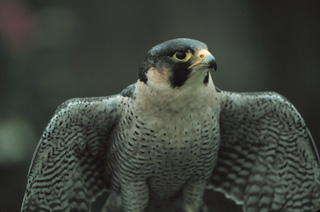![[Currents header graphic]](http://www.ucsc.edu/homeart/currents_header.gif)
![[Currents header graphic]](http://www.ucsc.edu/homeart/currents_header.gif)
September 7, 1998

|
|
An adult peregrine falcon (more photos)
|
By Tim Stephens
In 1970, wildlife biologists knew of only two pairs of peregrine falcons nesting in California. Now, there are approximately 150 nesting pairs and an estimated total population in the state of about 750 birds, according to Brian Walton, coordinator of the Santa Cruz Predatory Bird Research Group (SCPBRG) at UCSC. On August 25, the U.S. Fish and Wildlife Service (USFWS) announced a proposal to remove the peregrine falcon from the endangered species list. For Walton and his coworkers in the SCPBRG, this move represents the realization of a dream they have steadfastly pursued for almost 25 years.
"Our goal when we started was to build back the peregrine population until they could be removed from the endangered species list, so it's very satisfying," Walton said.
Peregrine falcon populations throughout North America crashed in the 1960s due to widespread contamination of the environment with the pesticide DDT. Peregrines absorbed the pesticide from their prey and accumulated high concentrations of it in their tissues. The toxin caused female peregrines to lay thin-shelled eggs that dried out or broke under the weight of the nesting adults. DDT was banned in the U.S. in 1972, but its residues still persist in the environment.
The SCPBRG was the brainchild of Santa Cruz veterinarian James Roush, who teamed up with the late UCSC biologist Kenneth Norris, professor of natural history, to establish the group in 1975 as a self-funded research group at UCSC. They asked Walton to run the program, and he's been overseeing it ever since.
Captive breeding was one technique Walton used to restore peregrine falcon populations. From 1976 to 1992, the SCPBRG operated a captive breeding facility at UCSC. In addition to peregrine falcons, the group successfully bred aplomado falcons, Harris hawks, and elf owls.
Peregrine chicks produced through captive breeding were typically raised by captive adult falcons for about five weeks and then released into the wild at a "hack site" when they reached the fledgling stage (the age at which birds learn to fly, 40 to 42 days for peregrines). Chicks were placed in a hack box high on a cliff and fed through a hatch for about one week until they were ready to fly, at which point the box was opened. Researchers monitored the birds for several weeks and provided food until they learned to hunt for themselves.
The SCPBRG also helped ensure the reproductive success of wild peregrines by removing fragile eggs from nests and hatching them in an incubator. Researchers replaced the real eggs with dummy eggs to keep the parents on the nest. Hatchlings were usually raised for two weeks in captivity before being slipped back into foster peregrine nests in the wild.
Altogether, the SCPBRG has released more than 800 peregrine falcons into the wild. Most of the release sites have been in California, but the group has also released falcons in Nevada, along the Columbia River gorge in Oregon and Washington, and elsewhere in Oregon. Similar programs have helped restore peregrine falcon populations in the Rocky Mountains, in the Midwest, and on the East Coast.
In 1992, the SCPBRG gave the last of its breeding falcons to The Peregrine Fund, which has a breeding program in Boise, Idaho. SCPBRG researchers continue to release captive-raised peregrines and monitor the recovery of peregrine falcon populations on the West Coast. They are also pursuing new projects involving other predatory bird species, including bald eagles and golden eagles. Their ongoing work with peregrine falcons includes monitoring eggshell thicknesses, banding nestlings, tracking released birds, and evaluating release techniques.
"We want to figure out which release techniques worked to get the most breeders into the population, which birds produce the most offspring, and how the population expands and disperses; it's a valuable opportunity to understand how the actual recovery of a species occurs," Walton said.
The group also rescues chicks from nests built in precarious locations, such as San Diego's Coronado Bridge and the San Francisco Bay Bridge. "Several pairs of peregrines have nested on bridges, and we move the nestlings to other sites because otherwise they fledge into the water and die," explained SCPBRG program manager Glenn Stewart.
Although peregrine falcon populations have increased enough for the USFWS to propose removing them from the federal endangered species list, their future is not necessarily a stable one. Pesticides are still causing problems in certain areas and peregrines have not fully repopulated their original range in California, Walton said.
"Our ongoing efforts will concentrate on the northern California coast, where the population size is still small, and on the Central Coast and Channel Islands, where reproduction is still reduced due to eggshell thinning," Walton said. "Our goal is not only to have them off the endangered species list but to have a stable California population."